A big thank you to Discover Corps for providing this wild adventure so we can share their good work. As always, all opinions are our own.

Ngorongoro Crater is a funny name no doubt, but it just might be the best place on the planet to see exotic animals up close in the wild.
The crater formed a few million years ago when a massive volcano collapsed onto itself leaving the largest intact caldera in the world.

The collapse also created a unique combination of elevations and ecosystems that have become home to over 25,000 of the most famous species of African wildlife.
The one-hundred square mile floor is surrounded by a mountainous rim that encloses a concentration of critters that is world renowned.
The entire crater- and much of the surrounding land – has been protected as the Ngorongoro Conservation Area.
Putting some tourism in our voluntourism visit to Tanzania, we spent the previous afternoon in the nearby Tarangire National Park, where elephants are the undisputed stars, then stayed the night in the small town of Karatu just outside of the crater.
WATCH: Watch as a mischievous baby elephant gets in trouble – and how the herd responds!


We woke before the first rooster crow and took off in our pop-top Toyota Land Cruiser.
Ngorongoro is known for its high concentration of lions, and early in the morning is often when they are on the hunt.
Sure enough, just as a foggy dawn was breaking near the top of the rim, we spotted a lioness in the brush along the side of the red dirt road.

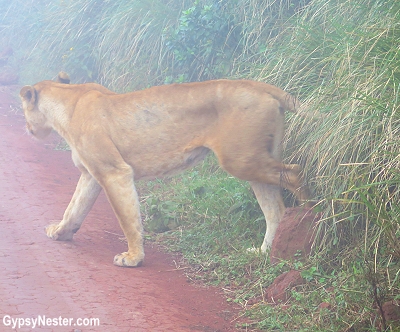
We watched in awed silence as another appeared behind her, and then another.
The trio walked through the bush not ten yards away from us, and then popped out onto the road directly behind the safari wagon and slowly sauntered away.

Seemed like this sighting would be tough to beat, but descending into the crater we soon realized that there would be many more moments to rival it as the day progressed.
First we passed several large herds of cape buffalo, along with many zebras grazing comfortably, seemingly without a care in the world about the many predators nearby.


In fact, several times we saw hyenas walking very close to zebras, gazelles, wildebeests, and birds, with the prey paying no mind to the hunter whatsoever.
We wanted to shout out to them – head’s up!, or behind you!, but our guide, Alan, said that they can tell when the hyenas are hungry and in hunting mode.
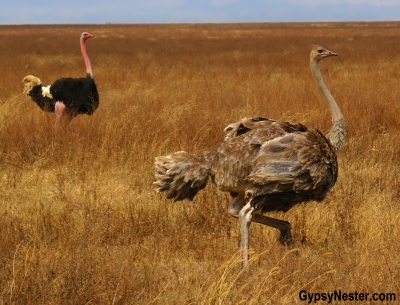
Next we came upon something unexpected, an ostrich. For some reason we didn’t think about the big birds as something that we would see here, but there are a few.
This particular male, Alan identified him as such because of his black feathers as opposed to the grey of the females, had a very red neck.

This showed that he was ready to rock mate, and as if on cue, up came a female doing her come-hither dance.
The two did their thing – very quickly we might add – and then strutted off on their separate ways.
To see our African journey from the very beginning, click here

But their time apart is only temporary, as we learned when we saw a mommy ostrich sitting on her nest.
Alan explained that the mates share nest duty, with the mother sitting on the egg all day, then it is dad’s turn at night.


Just beyond the ostrich lovefest we came to a hippopotamus pool and, as if that was not cool enough, there were five lions hanging out.
After a few minutes one of the hippos decided that three of the lions were too close, so he lumbered out of the water – no easy task for the big boy – and frightened them off.


They retreated about a hundred yards in the typical we meant to leave anyway manner that cats have, then laid back down – acting like it was their idea in the first place.
This was great for us because they decided to plop down right next to the road within a few feet of us!


The lions kept watch, then decided, “We’ll show those hippos who’s the boss around here.” and sauntered over to their original spot.

The hippos pretended not to notice.

We finally had to tear ourselves away from the scene, confident that something equally exciting would be waiting up ahead, and were not disappointed. Alan spotted a rare black rhino, there are only about five thousand left in existence, off in the distance.
Even though the endangered creature was too far away to photograph, we did get a pretty good look at him through the binoculars.

The kori bustard, however, was not so shy. As the largest bird in the world that can fly, we suppose he wouldn’t have to be!
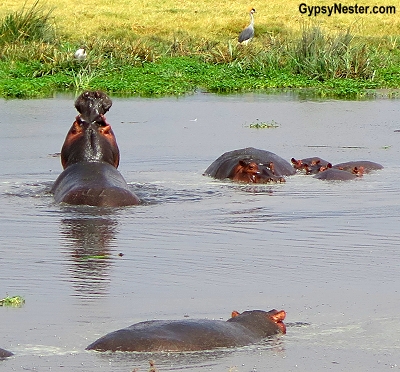
We noticed a group of safari vans up ahead and hurried to check out what they were up to.
More hippos!
Way more, we found a herd, or bloat, of around twenty or thirty hippopotamuses lounging in a swampy pond.
The hippopotami were doing what they always do when the sun is out – soaking in the water.


Their skin is very sensitive, so they stand (they can’t swim) in the pool all day and come out to feed on grass at night.
This behavior made us think that we were not going to see the group walking on land, but for some unknown reason one big guy decided to climb out and walk over to another nearby pool. Next thing we knew the entire bloat of bulbous blimps was parading across.
We were amazed as we watched the three-thousand pound beasts waddle across. It was somewhat like watching whales, which happen to be a close relative, take to the land.


Often birds, looking for bugs to snacks on, hang out near, or sometimes on, the bigger animals.
This pond was a good example of that behavior, with egrets and ibis all around.
We also found a new feathered friend, the yellow-billed stork.
Their humorous walking style had us humming Puttin’ on the Ritz, all they were missing was a little top hat jauntily perched on their heads.

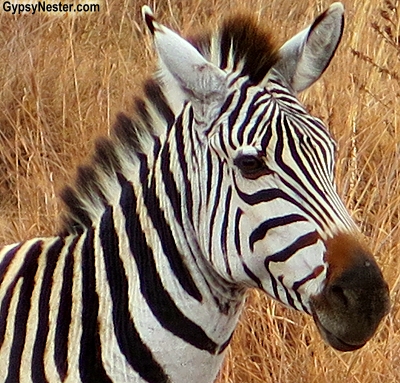
Ngorongoro’s awash with zebras.
We saw them almost everywhere, and our close proximity gave us the opportunity to observe many of their behaviors.
As a herd crossed in front of us – in their usual single-file lineup – we watched one after another roll around in the dirt for a good scratching, and to get rid of annoying fleas and ticks.

A couple of questions popped into our heads upon being so near to them:
Are they more like horses or donkeys?
Are they black with white stripes or white with black stripes?
We decided on donkeys and, upon viewing them from behind where the black strips don’t quite meet up, black on white. Mystery solved.

Later we observed a mother nursing her foal only a few yards away from our vehicle. Our host for our Tanzanian adventure, Mama Simba, was riding with us and explained that in the scores of safaris she has been on she had never before seen this.

WATCH: Cutest thing ever! This baby, fuzzy zebra has lunch and a romp!

We chose a spot by the water for an outdoor lunch, and couldn’t help but notice a great deal of elephant dung scattered around.
From that clue we probably should have expected the ginormous guest that walked right through the area just as we finished eating.
With an absolutely amazing morning behind us, we loaded back into the safari wagons and begin to make way for the climb back up the crater rim.


As we drove we got an incredible bonus, a big male lion completely laid out in the shade of a small tree.
Proving that it is good to be at the top of the food chain, this guy obviously had absolutely no fear from any predators, so he could sleep peacefully out in the open.
At the base of the rim the habitat changed and the forest thickened until it became more like jungle.


A large troop of olive baboons found this to be a perfect place to do a little snacking, picking at the trees for a bit of sap.
This merry band of primates would be the animals to bid us farewell to this phenomenal wildlife sanctuary.
To see our African journey from the very beginning, click here

David & Veronica, GypsyNester.com
Delve Deeper:
See our Tanzanian adventure from the very beginning
Click to see all of our adventures in Africa!
A big thank you to Discover Corps for providing this wild adventure so we can share their good work. As always, all opinions are our own.



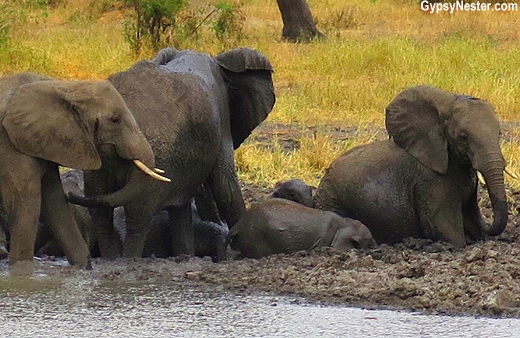

Some genuinely nice stuff on this site, I like it.
My first experience on y’all’s blog. Wonderful. And I’ll offer another plug for the book, which often made me for-real laugh out loud. I’ll keep reading and watching. Y’all go!
Thanks for stopping by Shannon. Always good to hear from you.
Loved your images of the animals in Ngorongoro Crater, especially the hippos!
Thanks Carole, the hippos were unexpected for us too.
I seriously think that the word “amazing” is way overused, but your photos and videos are just that. We saw the same animals in a reserve next to Kruger National Park in South Africa last year—including black and white rhinos—which brings us to another overused word—“awesome”, but it was just that as it appears your experience was. (We saw zebras, but not a baby zebra nursing). We also saw giraffes—did you see any of those? Your entire Africa trip just prompts so many of those “a” words.
Amazing and awesome both seem appropriate in this case. We did see giraffes, but not in the crater. There aren’t the trees that they like.
I’m not sure why, but I’ve always thought of zebras as white with black stripes. Somehow it appeals to my sense of balance. Looks as if you had an incredible experience. Love the photo of the hippo on his back in the muddy water with his belly popping up out of the water.
We thought so too. Also loved catching the hippo rolling ove. Pretty special day.
Amazing you could see so many animals in one day! An African safari is on our list and Tanzania looks like a great place to visit. I never knew a hippo group was a bloat!
We are hardly experts, but Tanzania sure worked for us. Bloat seems about right though, right?
What a breathtaking experience. I am so envious yet so thrilled for you!
On our visit to Tanzania, we never made it to the crater. I’ll just have to go back!
It’s worth it!
Zebra hoofbeats, elephants and ostriches, sleeping lions, rhinos bathing … You guys are living my all-time, number one bucket list dream! Awesome!
It was right up there on our list too Anita.
This place sounds magical. David and I are off to Africa next year maybe I can squeeze this into our itinerary.
If you can it will be well worth it.